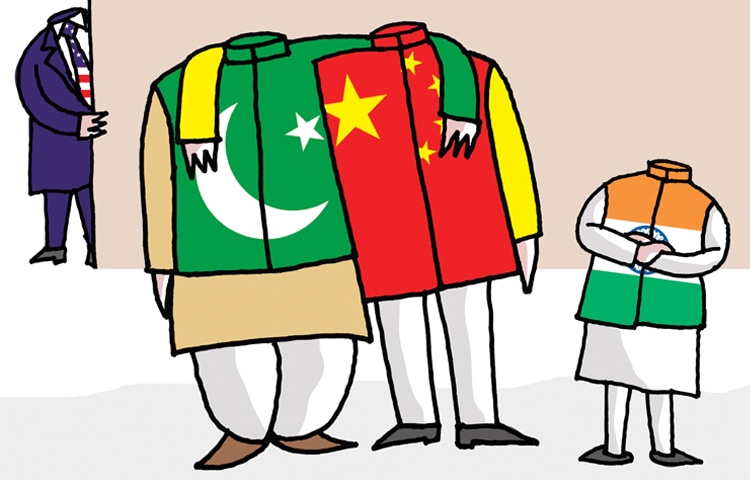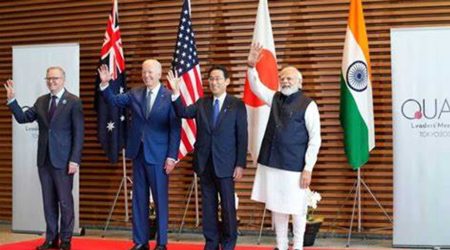Pakistan was created as a buffer state and India needs it more than ever
Maj Gen Sudhakar Ji
China is going to depute its own militia to protect its asset in Pakistan. They are also posting a Debt Management Officer at the embassy in Islamabad to closely monitor the investment and returns, and they are also proposing to run various services in Pakistan. Chinese are already providing backup services for the Pakistani rangers along the Indian border which is a major security concern for India.
Pakistan owes more than $24.7 billion out of its total external debt of $87.7 billion to China, according to the International Monetary Fund (IMF). China is its largest bilateral creditor, with outstanding loans of $14.5 billion. However, this number undercounts the true extent of Chinese lending to Pakistan under other categories. For instance, the latest Economic Survey lists a $7 billion loan extended by SAFE. Pakistan also owes $8.77 billion to “commercial banks”, which include banks from West Asia and three Chinese lenders — the Bank of China, ICBC, and China Development Bank, all state-owned banks.
The Asian Development Bank (ADB) at $14 billion and the World Bank (WB) at $18.1 billion are the other major lenders to Pakistan. While ADB and WB lending rate is around 3 percent, loans from Chinese banks are at 5.5-6 percent interest rates. During 2019-20, the total lending to Pakistan by Paris Club countries and China was about the same – but the interest outflow on Chinese loans was four times higher.
With foreign-exchange reserves at below $9 billion, or less than two months of imports, Pakistan faces the prospect of default for the second time in its history. In the meantime, there are talks about Pakistan intending to cede Gilgit-Baltistan, an Indian territory in Pak-occupied Kashmir (PoK), to China on lease in order to ease its financial pressure. The mineral-rich region has 50-100 gold and uranium mines according to the report of the Mineral Department of the PoK.
Any such move of ceding Gilgit-Baltistan to China could earn Pakistan hefty lease money that could help tide over its current economic woes. But this would also have the potential to mightily annoy the United States (U.S.) to deny or delay the $3 billion bailouts from the International Monetary Fund (IMF), and saving it from the guillotine of the Financial Action Task Force (FATF) probing financing of terrorism and proliferation.
Importance of Gilgit-Baltistan
Located at the confluence of three geographical regions – southern, central, and eastern Asia, Gilgit-Baltistan is connected with Afghanistan, Pakistan, India, and Tibet. Pakistan ceding Gilgit-Baltistan, which it illegally occupies, would be a boon for the Chinese expansion plan toward the Indian Ocean. The area borders PoK to the south, the province of Khyber Pakhtunkhwa to the west, the Wakhan Corridor of Afghanistan to the north, the Xinjiang region of China to the east and northeast, and the Indian-administered union territories of Jammu and Kashmir and Ladakh to the southeast.
Gilgit-Baltistan is the only territorial frontier, and a land route, that connects Pakistan with China through PoK. In wake of the Pakistan-Chinese bonhomie in the Himalaya at Karakoram Pass, India is strengthening its capabilities on the Darbuk-Shyok-DBO road in Eastern Ladakh to keep a close eye on the movement of the dragon and its scheming protégé.
Pakistan: Unstable and Unsustainable
Pakistan has been largely dependent on foreign aid since its independence in 1947. The International Monetary Fund (IMF) has lent money to Pakistan 22 times during the last 60 years and they all come with some stringent conditions.
Asian Development Bank (ADB) informs that it has committed 723 public sector loans, grants, and technical assistance totaling $37 billion to Pakistan since 1966 with the ongoing sovereign portfolio in Pakistan, including 48 loans and three grants worth $8.42 billion. The Islamic Development Bank has also provided Pakistan with total funding of $14.6 billion for 429 projects, of which 378 have been completed and 51 are active.
Eleven Chinese Independent Power Producers (IPPs) have invested $10.2 billion to generate 5,320 megawatts, but nearly 2,000 MW capacity power plants were shut last month due to a shortage of coal. Power plants threatened to stop their operations if the dues of Rs340 billion were not immediately clear. Pakistan was hoping for a cheap coal supply from Afghanistan but the Taliban has now increased the rates by 30 percent.
Moreover, there are more than 30 Chinese companies operating under the CPEC in several infrastructural projects in fields like energy, communication, railways, roads, and highways to facilitate trade connectivity.
Saddled with predatory Chinese loans in the Indian Subcontinent, Sri Lanka had already granted China a 99-year lease and 70 percent stake in its deep-water port Hambantota. The Maldives owes China roughly $1.5 billion in debt – about 30 percent of its GDP. Even India has recently emerged as a top borrower from the China-sponsored Asian Infrastructure Investment Bank (AIIB).
View from Peshawar
While Pakistan is facing an acute financial crisis, the budget for defense has increased immensely. The Pakistani army has awarded itself an 11 percent increase in budgetary allocation in FY 2021-22.
Historically, the Pakistani establishment has been a deft hand in playing a double hand with its allies. They have bled the U.S. throughout the cold war, the U.S. and Saudi Arabia in the name of “Jihad” in Afghanistan in the last 20 years, and now China has become their biggest benefactor. With the “Mullah and the Comrade” project not yielding the desired results and deteriorating security conditions on the ground, for Chinese are now focusing to turn malleable Pakistan into another Myanmar. The supreme aim of China in Pakistan remains access to the Indian Ocean and energy security.
The opening of the Indian diplomatic mission in a reduced capacity has not gone down well with Pakistan. Experts believe that as the Islamic State (IS) of Khorasan intensifies its activities in Afghanistan, it would not only keep the Taliban on the tenterhooks and subservient to Pak interest but also keep the Chinese frightened. Pakistan has earlier played on the fear of the west and now it may play the same trick with its Eastern benefactor.
Moreover, compelled to meet debt service requirements, Pakistan is imposing budget cuts, withdrawing subsidies including on food, fertilizer, and fuel, and cutting wage bills at a time when people were in greater need of support from the government at a great social cost.
A $3 billion tranche from Saudi Arabia and another $4 billion from China’s State Administration of Foreign Exchange (SAFE) would not solve Pakistan’s woes. The solution lies in taking a cue from Bangladesh, formerly Eastern Pakistan, and try becoming a progressive nation focused on trade, economy, and societal welfare instead of being a den of global terrorism and exporting terrorists all across the globe.

(Maj Gen (Rtd.) Sudhakar Jee, VSM is a former colonel of the Mahar Regiment. He has commanded troops in varied terrain, climate, and conflict zones. Currently, he is pursuing a doctoral thesis on the India-China border dispute.)
==
Disclaimer: The views expressed are not necessarily those of The South Asian Times












